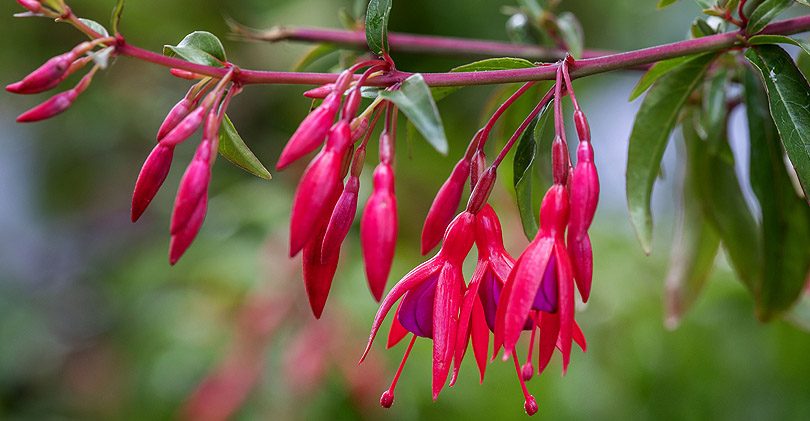Ph. Luciano Movio
“The Fuchsia is the perfect example of the art of flower growing. There is no better example of the pinnacle that this art may reach.”
Sacheverell Sitwell from the book titled “Old Fashioned Flowers”, ED. Country Life Ltd. 1948
The official flower of Orticolario 2017 is the Fuchsia spp., which will dance like tiny ballerinas through the days and nights of the ninth edition.
It is a flower of countless shades and tones, both its flower and its foliage. The Fuchsia is the perfect embodiment of love between gardener and plant. As early as the 1800s, the enthusiasm for this spectacular flower was the impetus for expeditions to the most exotic islands of the new world in search of new varieties. Guided by the constellations and the Moon, weathered sailors and fearless botanists went in search of new plants, returning with innumerable varieties of this garden delicacy.
Like ballerinas in a row, steadfast and poised.
The first to appear on the garden’s stage, with their simple little dresses, are the Fuchsia triphylla transported from the heat of Haiti to the shade of our gardens to provide us with a taste of the tropics at home.
All Fuchsia have composite flowers, which consist of petals and sepals, the names given to the layers of tulle and silk that make up the tutus worn by our ballerinas.
The stunning F. triphylla along with the F. magellanica are the ballerinas of our exotic garden dance. These plants often require special attention in winter to prevent them from fading away. If they are kept warm, we will be repaid by their luxurious flowers, the sensuality of various styles and the purity of their long and richly coloured pistils.
However, it is not only its flowers which make the Fuchsia a source of admiration for gardeners, it is also its foliage, in various shades of metallic green, occasionally textured like velvet.
Simple flowers, bearing violet fruit, in some cases rich and juicy. Twin flowers with large, multi-coloured buds, eventually dry on the plant until they fall to earth in their last fatal leap.
It is admirable to observe the courtship between plant and man.
Between the flower and the gardener, which, for envy or love, works tirelessly to ensure the plant is in blossom. In the majority of species, a constant flowering is that which we are called to guarantee for this plant. Like all dancers, they love the good life and a rich and abundant earth. They dislike the humid and the stagnant, one must constantly and dutifully water and fertilise the Fuchsia.
The relationship between gardener and Fuchsia, is a dance based on hopes and expectations. A delicate dance, where the two protagonists brush against each other ever so lightly. Where the world around the dancers fades away and only the dancers remain, the flower of the Fuchsia and the hand of the gardener. A giant and a fragile ballerina. There is only one spectator to this dance: the Moon. An envious spectator who tries with her movements to enter into the dance, to take part in the scene. However, the Moon is confined to her place above the garden, far from the dancers and the lovers. The solitary moon dances alone, shining her light on the dancers, lighting up the love in the garden. The love between man and flower, between the gardener and the Moon.
The delicate Fuchsia, especially when planted in a pot, appreciate our tender, nurturing hand to protect them from the cold and direct sunlight, which can threaten to rob us of our beloved plant.
It is said that all Fuchsia plants are beautiful, all of its flowers are relished. But a Fuchsia plant, the gift of a vase in spring or in autumn, blossoming and well-nourished is a long-awaited gift. Only the Fuchsia can win over human love, only the Fuchsia and the adversarial Orchid, for 200 years, these two plants have ignited a feverish passion amongst their greatest admirers which springs from a total and unconditional love for them.
Cultivate the Fuchsia, tend to them in your garden, be enchanted by them and become their lover. You will relish the beautiful, long, tapered legs of this ballerina of the garden.
Matteo Ragni
Comitato Scientifico Orticolario


